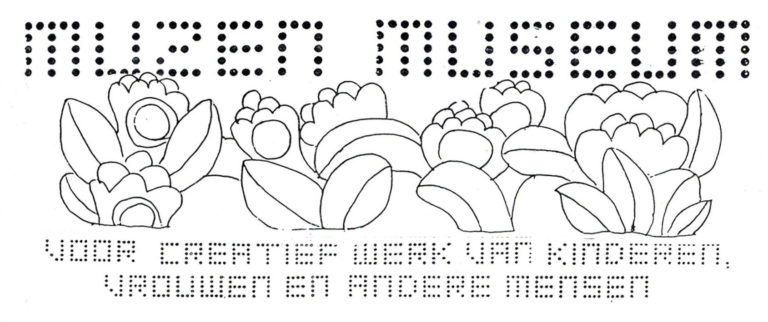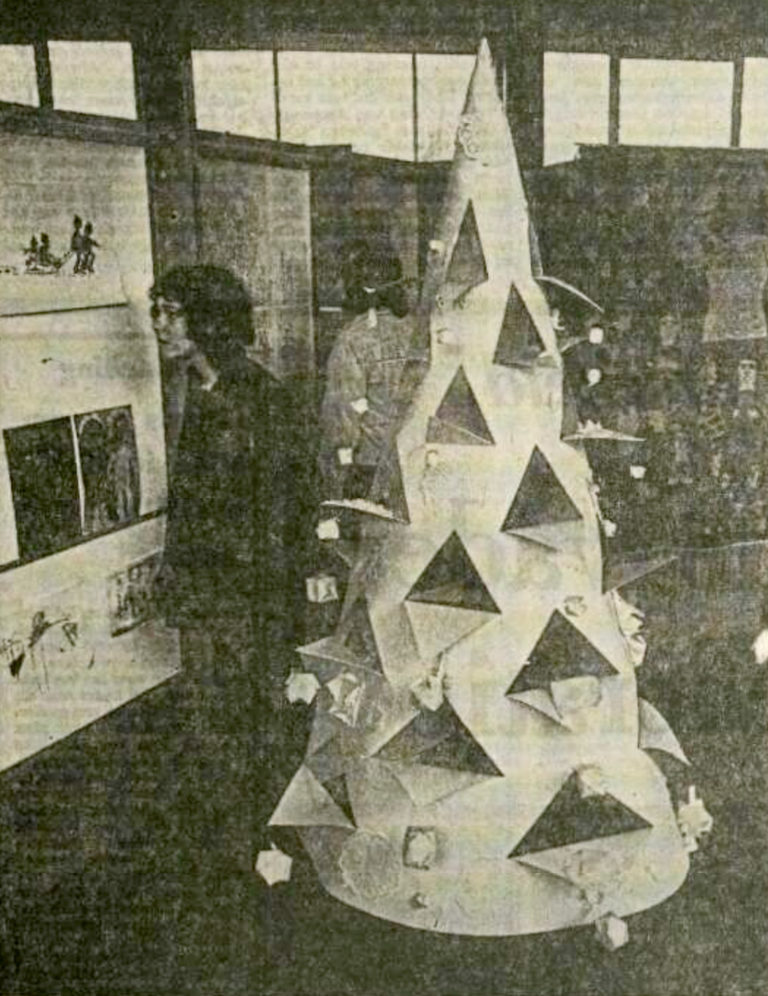GREAT WORK BY LAYMEN IN EXHIBITION (1974)
in Nederlands: GAAF WERK VAN LEKEN IN EXPOSITIE
BERGEYK Annet Teunissen van Manen-Zanen (56) is a woman with an ideal! All vacant valuable or worthless buildings like cinemas, schools, castles can be used (even if only temporarily) for lay people to do (group) activities in various creative fields: painting, drawing, sociodrama, working with textiles or waste materials. The impetus is there. In the middle of Bergeyk in the Kempen country, at the Eersel-Valkenswaard-Luykgestel intersection, there is a proud wooden fence with the letters: “Muzen Museum for creative work by children, women and other people”. The “signboard” for an old cinema, on which director-inspirer Annet and her husband and six children (of which the oldest 25 and the youngest 16 years old) threw themselves into transforming the ruins it used to be into a ‘workplace’, where young and old people aged 2-82 can practice and exhibit creativity.
They use materials such as corrugated cardboard, multicolored rolls of remnants of textiles, glued to a plateau at unequal heights. People can “Get ideas and bring ideas”, someone wrote after a tour of this unique building. “Every person should have the opportunity to exhibit something made with love. It is also exciting to see what others are doing,” says Annet TvM-Z. In the “Muzen Museum” no Karel Appel or Jan Cremer, but there is a moving painting made of mussel shells (by a grandmother), tapestries woven by Egyptian children (recently loaned to the Stedelijk Museum) and group drawings of French youth. Subject: Notre Dame.
The uniqueness of this museum is that people all over the world have similar choice of materials, but how much their workpieces differ! It also turns out that you don’t have to throw anything away, no crooked can opener, no beer bottle cap, no leftover wool. Pop art can be made of that. Annet TvM-Z: “I want to create new types of musea, in which you can see, hear [smell] and read in a creative way”. Not a single muse has been forgotten (“in the past there were no musea, which only showed paintings and sculptures. With the ancient Greeks, a museum was a place where the ‘muses’ played, including music”). Therefore not only visual expression, but also the spoken word, movement expression and film in Bergeyk. Annet collected original melodies on tape. Texts are written on cardboard inserts and hang from the exhibition panels. For example, a toddler while playing an awe-inspiring solo song.
There is also fashion to see. In the back of the room dresses from the Rietveld Academy, a decorated postman cape and shoes made of a piece of suede, which a childs uncle folded her toes ‘because the shoe is so hard’. A medical student from Amsterdam made “machine beasts” and before studying medicine, he assembled fantasy motorcycles, drawn with tiny numbers and figures, assembled into the model of a motorcycle. Another technician made crazy old cars out of ribbon-thin strings of waste tin.
How did Annet TvM-Z., who lives in a beautiful bungalow near the museum in the woods, develop this idea? “It’s a growing process,” she says. “In 1966, on the grounds of “De Ploeg”, a weaving mill run by the Bergeyk work communities foundation built small public open air creative recreation pavilions for instance claying, drawing, making radio plays; sociodrama. You could also do interior design in groups using real chairs and tables, but you could also help give suggestions. What the people wanted could be made available in other pavilions. A people-oriented event, not a business matter.
There are so few opportunities to be creative in the open air in public. Yes you can swing, watch windmills, but really making something together, things you do at home, is not one of them. With group work in the open, people see different techniques and can gain courage, ideas and socialise.
In America I gave a lecture to the International Society for Education of Art in New York. That is where my thoughts took shape: Establish a museum for people who are not craftsmen. The intention is to make it a foundation and to delegate work. I would like to work with a permanent staff, part-timers, students. We already have an empty school in mind in Amsterdam. We also see our aspiration in connection with the ‘Year of Women’ in 1975. It is especially important for women to develop creatively. The possibilities are there. So many companies and factories, which we may use. Empty churches too. Once they’re back in service, load things up in the small car and away you go. It’s about creating jobs. Working creatively with waste material from companies (which we do already) is also a form of avoiding environmental pollution.
If you just wait a while before you throw away paper and junk, you see what I mean. We currently have worked with 47 countries in Bergeyk. There were 10,500 visitors, including 15 groups and alternative school trips. Even the dairy farmers’ association wants to go on a day trip to visit the museum…”
In the Muzen Museum, any object no matter how absurd, can become an object to enjoy. Anyone can submit, because, says Annet: “If a lay(wo)man is creative, (s)he deserves attention.”
© foundation eye to eye amsterdam 2024


